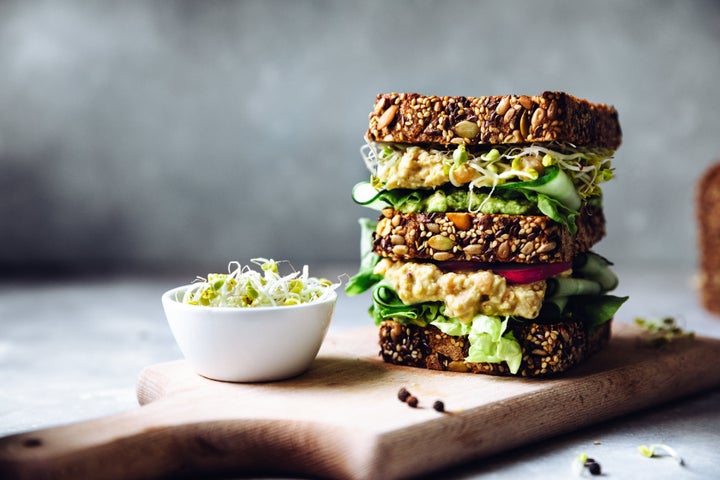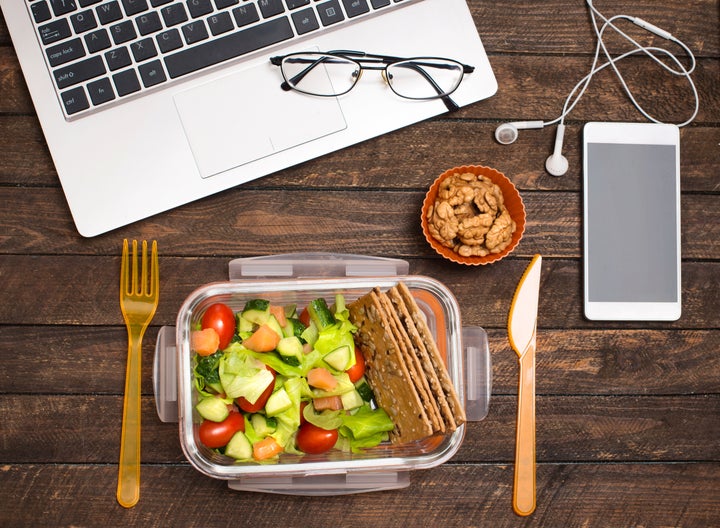
The old saying goes: “Eat breakfast like a king, lunch like a prince and dinner like a pauper.” In present-day America, however, our approach to meals tends to be the opposite.
There are a few theories behind why we seem stuck in a pattern with dinner as the heaviest meal. A 2015 Washington Post article references a study on circadian rhythms possibly causing hunger spikes and cravings for sweet, salty, starchy foods later at night, along with the suggestion that this may be due to evolution: It was once efficient for humans to eat late at night in order to store energy as fat and glycogen for the next day. There’s also the hormone factor: Cortisol and adrenaline drop off midday, so if we’re working late into evening or night, we’re looking for a boost from food.
And then there are work schedules, which seem to be the most prevalent and inescapable driver of today’s eating habits ― habits detrimental to health and well-being, negatively affecting everything from sleep to waistlines.
“I think it’s all wrong,” said Patrick Okolo III, chief of gastroenterology for Rochester Regional Health. Okolo said it’s important to view the implications of eating our largest meal latest in the day from a digestive standpoint, as well as an overall health perspective. As for the latter, we don’t metabolize food as well at night because of the normal, natural rhythm of the body.
“In America, we rush through meals and don’t give ourselves the proper attention our minds and digestive and nervous systems need. We treat lunch especially like an obstacle in our day rather than celebrating it.”
- Katie Schmidt, behavioral food therapist
Having the largest meal at night leads to sleep disturbances, acid reflux and other long-term digestive problems. It also means food gets stored in our bodies at a time when we’re not using it, which can then be manifested as fat tissue.
“The pounds we pack on and our perpetual place as global leaders in obesity is really in many parts because of this pattern of eating late at night,” Okolo told HuffPost. He noted there is controversy around whether breakfast or lunch should be our biggest meal, but a definitive line can be drawn around late afternoon, after which we get a diminishing return on what we eat.
Okolo also pointed out the prevalence of reflux disease due to eating later. A full stomach causes a great deal of acid, which leads to sleep disturbance and a number of health consequences, he explained.
How we got to this point
Americans didn’t always eat this way. The midday meal was once the heaviest, and the shift toward evening came from how and where we work, according to Sarah Lohman, a culinary historian and author of ”Eight Flavors: The Untold Story of American Cuisine.”
Pre-Industrial Revolution, Lohman explained, society was more agrarian. Families worked on their own farms. They ate their heaviest meal midday (what we now call lunch was then called dinner; what’s now dinner was “supper”), because this provided the necessary fuel for their labor and also because it was possible to stop for a couple of hours to cook and eat. People controlled their own work schedules, and were already near the house, no travel time needed. The evening meal was typically leftovers, often cold.

This didn’t change right away as labor became more industrialized, Lohman noted. People still generally lived close to their jobs, and children to their schools, so it was easy enough to walk home to eat the day’s biggest meal as a family, then return to the day. As we moved further into the 20th century, though, and people began commuting greater distances, often from suburbs into cities, it became impossible to go home midday to eat.
“It’s then that people start packing sandwiches or buying light food locally,” Lohman said. “So, the shift in commuting shifts the big family meal toward the end of the day when everyone is home.”
This flip of the midday and evening meals was born out of necessity, but not without concern it could negatively impact health. Lohman cited Fannie Farmer’s seminal 1896 ”The Boston Cooking-School Cookbook.” While it doesn’t mention worries around meal timing, it is an example of how turn-of-the-century cookbooks started paying close attention to health and nutrition.
Elsewhere, uneasiness about late-night eating began appearing. Winsor McCray’s newspaper comic strip ”Dream of the Rarebit Fiend” launched in 1904, focused on a character who had nightmares from eating Welsh rarebit too late in the evening ― the correlation between late meals and disturbing dreams is something we know more about today.
In other parts of the world, people follow much more health-friendly patterns. Approaches taken in parts of Africa and Southeast Asia make more sense for our bodies, Okolo said. There, people are more likely to be working on farms, eating heavier meals earlier and burning that food off, and then eating lighter at night. “In many cultures, people eat heaviest in the afternoon, and that translates to generally better health,” he said.
“There is controversy around whether breakfast or lunch should be our biggest meal, but a definitive line can be drawn around late afternoon, after which we get a diminishing return on what we eat.”
The problem is, there’s no sign that American work culture and schedules are changing. We are no longer an agrarian society. We work long hours without structured breaks and often at sedentary jobs. As Lohman pointed out, even the mass transition of office employees to remote work due to the coronavirus pandemic does not translate into having more time to enjoy lunch. Our work schedules still don’t allow us the time to stop everything and cook for ourselves and our families until the workday is over.
How to implement healthier eating patterns
So, what can we do to approach meals in a more beneficial way when the very nature of contemporary society makes doing so difficult? First, don’t split hairs on time. We all have different schedules, further complicated during this pandemic. Okolo noted that some people eat breakfast at 11 a.m., when others are eating lunch at that time. Just make sure your larger meal is timed for your most active time of the day.
While most of us don’t have time to halt our day and cook, it can be a health game-changer to carve out even a short break to step away from the computer and focus on a meal.
“In America, we rush through meals and don’t give ourselves the proper attention our minds and digestive and nervous systems need,” behavioral food therapist Katie Schmidt said. “We treat lunch especially like an obstacle in our day rather than celebrating it as an event to look forward to and an anchor to recenter and pivot in our day.”
This means taking even just a beat to make sure lunch is full of nutrients to provide energy for the rest of the day ― energy we’ll be expending, not storing. This doesn’t require elaborate cooking. And we can still look forward to dinner as our work-is-done meal, or our family meal. But it should be a lighter affair.

The first step is finding the balance that feels right for you and your day, since everyone tends to operate at different levels of activity. You don’t want to be bogged down after lunch, but that doesn’t mean lunch shouldn’t be the heaviest meal of the day. It’s about what you’re eating and how economical it is in terms of nutrients per calorie.
“I often see people shy away from eating a heavier meal at lunch because they’re afraid of feeling sluggish or lethargic in the afternoon,” Schmidt said. “But eating a heavier meal doesn’t necessarily mean it has to feel heavy in our body.”
“Focus on packing in nutrients versus adding extra empty calories,” registered holistic nutritionist and culinary consultant Peggy Kotsopoulos said, stressing that lunch should be larger than dinner, but with a focus on density in nutrients.
It’s better to get your carbs at lunch, Kostopoulos added, as our bodies have a better time regulating blood glucose levels and utilizing these sugars as fuel earlier in the day. After this larger meal at lunchtime, you’ll feel more inclined to go lighter at dinner, even if it’s the meal you’re looking forward to most.
Aim for healthy fats and proteins at lunch, too, in addition to those complex carbs, Schmidt advised. Think about a goal of getting about 10 servings of plant foods each day, including fruits, vegetables, herbs, spices, legumes, nuts, seeds and whole grains, and which of those you can easily and conveniently work into your midday meal.
Feel like you’re running out of lunch ideas? In addition to protein-packed salads, consider dishes that are short on prep time and can be made for a few days at a time, like hearty soups, stews and curries, which Schmidt recommends as easy one-pot meals. They’re “a streamlined way of getting everything I need into one bowl, without much effort,” she said. “Similar to a capsule wardrobe, there are numerous ways to mix and match staple ingredients (such as greens, root vegetables, spices, herbs, lentils, and beans) and create seemingly limitless one-pot meal variations. And having a pot of soup in the fridge also makes it quick to warm up for lunch at home, or to pack in a thermos if you’re heading out.”
Meal prep could very well be the secret to quick and effortless lunches that are healthy, filling, energy-boosting, and enjoyable, which could also be a much needed mental reset during the day even if the break is short. For dinner, think more about the ritual, whether it’s catching up with the kids or unwinding with some music, and find the joy in lighter, easier options like leftovers, salads or maybe some healthy takeout.